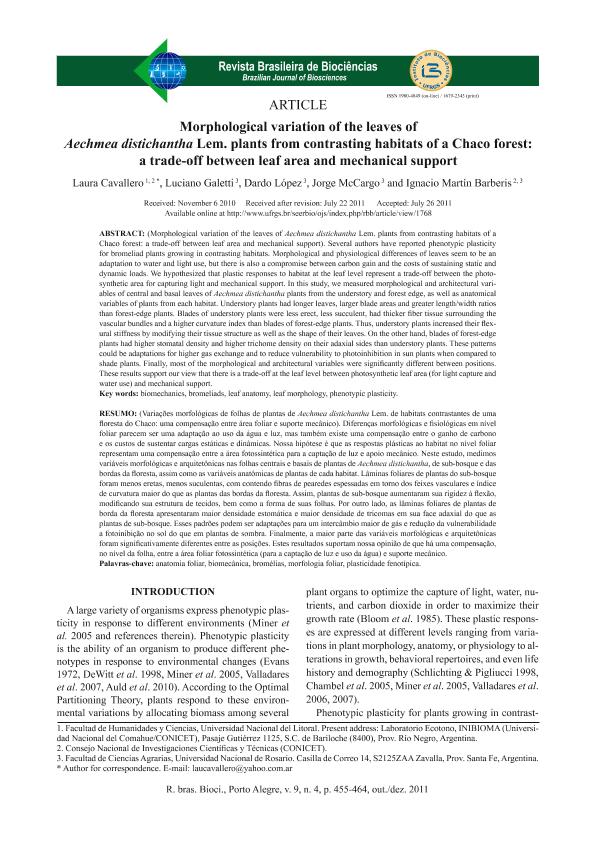Mostrar el registro sencillo del ítem
dc.contributor.author
Cavallero, Laura

dc.contributor.author
Galetti, Luciano Alberto

dc.contributor.author
López, Dardo Rubén

dc.contributor.author
Mc Cargo, Jorge
dc.contributor.author
Barberis, Ignacio Martín

dc.date.available
2019-05-20T18:28:33Z
dc.date.issued
2011-12
dc.identifier.citation
Cavallero, Laura; Galetti, Luciano Alberto; López, Dardo Rubén; Mc Cargo, Jorge; Barberis, Ignacio Martín; Morphological variation of the leaves of Aechmea distichantha Lem. plants from contrasting habitats of a Chaco forest: a trade-off between leaf area and mechanical support; Universidade Federal do Rio Grande do Sul. Instituto de Biociências; Revista Brasileira de Biociências; 9; 4; 12-2011; 455-464
dc.identifier.issn
1679-2343
dc.identifier.uri
http://hdl.handle.net/11336/76729
dc.description.abstract
Several authors have reported phenotypic plasticity for bromeliad plants growing in contrasting habitats. Morphological and physiological differences at the leaf level seem to be an adaptation to water and light use, but there is also a compromise between carbon gain and the costs of sustaining static and dynamic loads. We hypothesized that plastic responses to habitat at the leaf level represent a trade-off between photosynthetic area for light capture and mechanical support. In this study, we measured morphological and architectural variables on central and basal leaves of Aechmea distichantha plants from understory and forest edges, as well as anatomical variables for plants from each habitat. Understory plants had longer leaves, larger blade area and greater length/width ratios than forest-edges plants. Blades of understory plants were less erect, less succulent, had thicker fiber tissue surrounding the vascular bundles and higher curvature index than blades of forest-edge plants. Thus, understory plants increased their flexural stiffness by modifying their tissue structure as well as the shape of their leaves. On the other hand, blades of forest-edge plants had higher stomatal density and higher trichome density on their adaxial side than understorey plants. These patterns could be adaptations to higher gas exchange and to reduce vulnerability to photoinhibition in sun than in shade plants. Finally, most of the morphological and architectural variables were significantly different between positions. These results support our view that there is a trade-off at the leaf level between photosynthetic leaf area (for light capture and water use) and mechanical support.
dc.description.abstract
(Variações morfológicas de folhas de plantas de Aechmea distichantha Lem. de habitats contrastantes de uma floresta do Chaco: uma compensação entre área foliar e suporte mecânico).Diferenças morfológicas e fisiológicas em nível foliar parecem ser uma adaptação ao uso da água e luz, mas também existe uma compensação entre o ganho de carbono e os custos de sustentar cargas estáticas e dinâmicas. Nossa hipótese é que as respostas plásticas ao habitat no nível foliar representam uma compensação entre a área fotossintética para a captação de luz e apoio mecânico. Neste estudo, medimos variáveis morfológicas e arquitetônicas nas folhas centrais e basais de plantas de Aechmea distichantha, de sub-bosque e das bordas da floresta, assim como as variáveis anatômicas de plantas de cada habitat. Lâminas foliares de plantas do sub-bosque foram menos eretas, menos suculentas, com contendo fibras de pearedes espessadas em torno dos feixes vasculares e índice de curvatura maior do que as plantas das bordas da floresta. Assim, plantas de sub-bosque aumentaram sua rigidez à flexão, modificando sua estrutura de tecidos, bem como a forma de suas folhas. Por outro lado, as lâminas foliares de plantas de borda da floresta apresentaram maior densidade estomática e maior densidade de tricomas em sua face adaxial do que as plantas de sub-bosque. Esses padrões podem ser adaptações para um intercâmbio maior de gás e redução da vulnerabilidade a fotoinibição no sol do que em plantas de sombra. Finalmente, a maior parte das variáveis morfológicas e arquitetônicas foram significativamente diferentes entre as posições. Estes resultados suportam nossa opinião de que há uma compensação, no nível da folha, entre a área foliar fotossintética (para a captação de luz e uso da água) e suporte mecânico.Palavras-chave: anatomia foliar, biomecânica, bromélias, morfologia foliar, plasticidade fenotípica.
dc.format
application/pdf
dc.language.iso
eng
dc.publisher
Universidade Federal do Rio Grande do Sul. Instituto de Biociências
dc.rights
info:eu-repo/semantics/openAccess
dc.rights.uri
https://creativecommons.org/licenses/by-nc/2.5/ar/
dc.subject
Biomechanics
dc.subject
Leaf Anatomy
dc.subject
Bromeliads
dc.subject
Phenotypic Plasticity
dc.subject
Leaf Morphology
dc.subject.classification
Otras Ciencias Biológicas

dc.subject.classification
Ciencias Biológicas

dc.subject.classification
CIENCIAS NATURALES Y EXACTAS

dc.title
Morphological variation of the leaves of Aechmea distichantha Lem. plants from contrasting habitats of a Chaco forest: a trade-off between leaf area and mechanical support
dc.title
Variações morfológicas de folhas de plantas de Aechmea distichantha Lem. de habitats contrastantes de uma floresta do Chaco: uma compensação entre área foliar e suporte mecânico
dc.type
info:eu-repo/semantics/article
dc.type
info:ar-repo/semantics/artículo
dc.type
info:eu-repo/semantics/publishedVersion
dc.date.updated
2019-04-23T15:05:24Z
dc.identifier.eissn
1980-4849
dc.journal.volume
9
dc.journal.number
4
dc.journal.pagination
455-464
dc.journal.pais
Brasil

dc.journal.ciudad
Puerto Alegre
dc.description.fil
Fil: Cavallero, Laura. Consejo Nacional de Investigaciones Científicas y Técnicas. Centro Científico Tecnológico Conicet - Patagonia Norte. Instituto de Investigaciones en Biodiversidad y Medioambiente. Universidad Nacional del Comahue. Centro Regional Universidad Bariloche. Instituto de Investigaciones en Biodiversidad y Medioambiente; Argentina. Universidad Nacional del Comahue. Centro Regional Universitario Bariloche. Laboratorio de Ecotono; Argentina
dc.description.fil
Fil: Galetti, Luciano Alberto. Universidad Nacional de Rosario. Facultad de Ciencias Agrarias; Argentina
dc.description.fil
Fil: López, Dardo Rubén. Universidad Nacional de Rosario. Facultad de Ciencias Agrarias; Argentina
dc.description.fil
Fil: Mc Cargo, Jorge. Universidad Nacional de Rosario. Facultad de Ciencias Agrarias; Argentina
dc.description.fil
Fil: Barberis, Ignacio Martín. Consejo Nacional de Investigaciones Científicas y Técnicas. Centro Científico Tecnológico Conicet - Rosario. Instituto de Investigaciones en Ciencias Agrarias de Rosario. Universidad Nacional de Rosario. Facultad de Ciencias Agrarias. Instituto de Investigaciones en Ciencias Agrarias de Rosario; Argentina
dc.journal.title
Revista Brasileira de Biociências
dc.relation.alternativeid
info:eu-repo/semantics/altIdentifier/url/http://www.ufrgs.br/seerbio/ojs/index.php/rbb/article/view/1768
dc.relation.alternativeid
info:eu-repo/semantics/altIdentifier/url/http://www.scielo.org.co/scielo.php?script=sci_nlinks&ref=022992&pid=S0120-2812201600040001000007&lng=es
Archivos asociados
